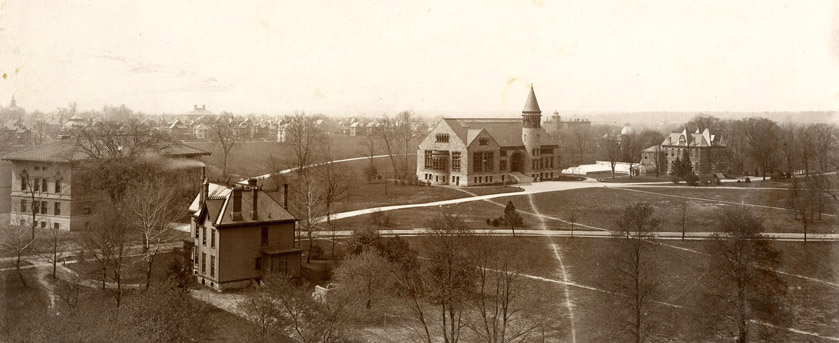The Archives recently received a small donation of material that belonged to a former OSU professor who was regarded as “one of the greatest botanists of his day.”
John Henry Schaffner came to the University in 1897 as an assistant in Botany, and served as head of the Department of Botany from 1908 to 1918. Later in his career, he went on to make a radical discovery in in the field of Botany that brought admiration from scientists worldwide. But more about that in a bit.
Early on in Schaffner’s tenure at OSU, he took the following photographs, which depict a very different view of campus.
This first photograph was taken from the top of the Armory in 1899. (The Armory was situated at the site where the Wexner Center sits today.) What we now think of the Oval did not quite exist yet, and as you can see, a house sat at the east end. In 1902, the house was moved to the north edge of today’s Mershon Auditorium and became the home to OSU athletics. It was aptly named the “Athletic House.”
To the left of the house is Biological Hall, which was built in 1898 for the departments of Anatomy and Physiology, and Botany and Zoology. The Biology Building was torn down in 1923 to make way for the current Hagerty Hall building.
To the right is Orton Hall, and the old Botanical Hall, which is where Schaffner spent much of his time in teaching and research.
This panorama photo shows a view of campus from the southeast end, looking northwest. You can see the back side of Orton Hall towards the right, as well as McMillin Observatory, which was situated on the southwest side of Mirror Lake. The observatory, which opened in 1896, was torn down in 1976.
But, what are even more interesting than Schaffner’s photographs, are his background and research interests. Schaffner was widely known among scientists for his botanical discoveries, and as a prolific writer of books and scientific papers. He was also renowned for his help in overthrowing the thought that the sex of plants was hereditary.
Yes, you heard right.
An Alumni Monthly article from October 1928 noted that Schaffner’s most important discovery is that the sex of the plant may be changed:
“Professor Schaffner found that by controlling the conditions in which a plant developed he could change the entire sex of the plant. The further development of this discovery will lead to many radical changes in the treatment of plant life.”
Schaffner read his paper describing this discovery in 1926 at a convention of botanists in Ithaca, New York, and it was widely acclaimed by scientists in many countries.
Schaffner died on January 27, 1939.
(Special thanks to Bob Cody, Schaffner’s grandson, who donated the campus photographs to the University Archives.)






Recent Comments